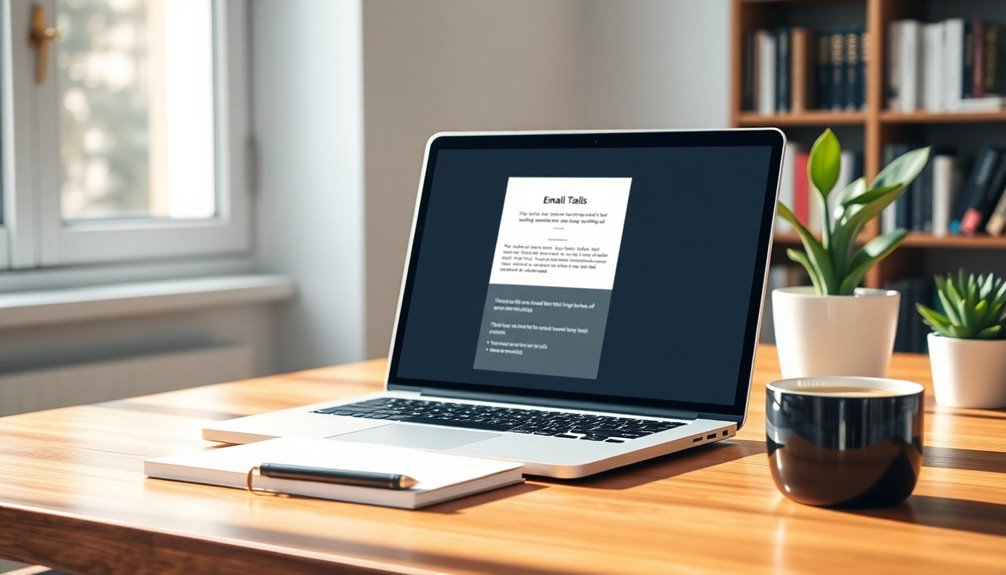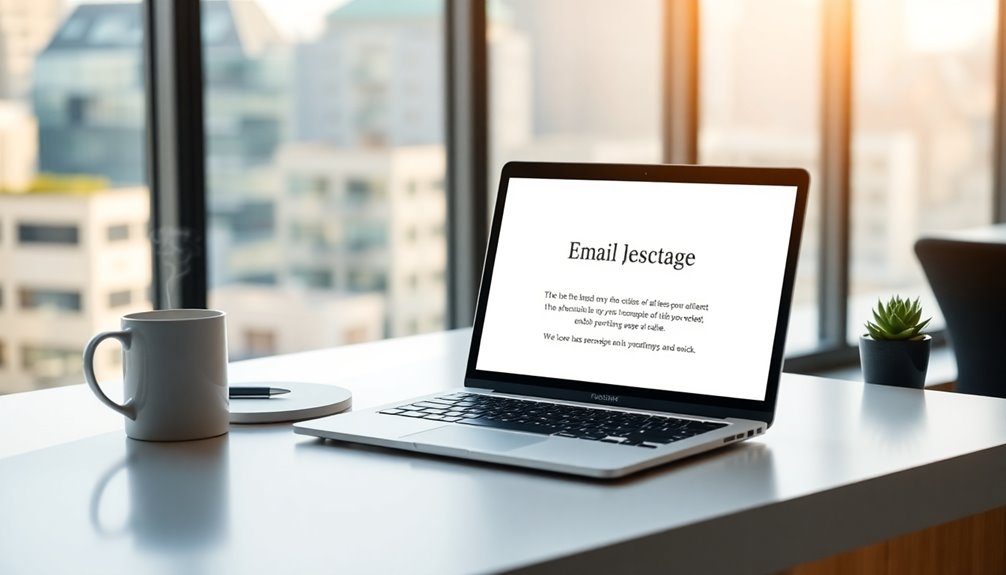To open doors with prospective clients, craft a personalized email that speaks directly to their needs. Start with a friendly greeting using their name and mention mutual connections. Clearly state your value proposition while addressing their specific pain points. Keep it concise, under fifty words, and include a strong call to action—like scheduling a call or replying. Use industry statistics or success stories to spark interest and build trust. Lastly, follow up diligently, as many touchpoints may be necessary. With the right approach, you'll engage them effectively, and more insights await just ahead.
Key Takeaways
- Personalize subject lines and greetings to enhance engagement and make your email stand out.
- Clearly define the value proposition and address the prospect's specific pain points early in the email.
- Include a compelling offer or incentive to encourage immediate action from the recipient.
- Use a strong, clear call to action that guides the recipient on the next steps to take.
- Follow up consistently to maintain interest and increase chances of conversion through multiple touchpoints.
Introduction

In today's fast-paced business world, crafting an effective introductory email is essential for building strong relationships with prospective clients. Your email's first impression sets the tone, so it's crucial to personalize it.
Start by addressing the recipient by name and referencing specific details about their company name. This personalization increases engagement and shows you value their unique needs.
Keep your introduction concise, ideally around three sentences. Clearly articulate your value proposition, highlighting how your offerings align with the prospect's needs. Additionally, consider the importance of user consent to ensure that your outreach respects their privacy preferences.
This brief, targeted approach not only piques their curiosity but also demonstrates your understanding of their business challenges. Additionally, consider utilizing effective email marketing strategies that can enhance your outreach efforts and maximize engagement.
Builds Initial Trust Quickly

Crafting a personalized email not only captures attention but also builds initial trust quickly. When you start with personalized greetings that use the recipient's name, you can boost open rates by 26%, creating an immediate connection.
Mentioning a mutual connection or referral enhances your trust and credibility, making the recipient more likely to engage further.
To solidify this trust, highlight benefits tailored to the prospect company's specific pain points. This shows that you genuinely understand their needs and aren't just sending a generic pitch. Incorporating elements of mental clarity into your communication can further resonate with potential clients, as it demonstrates an awareness of their cognitive needs.
A clear call to action at the end of your email invites the prospect to take the next step and reinforces your eagerness to help rather than just sell.
Don't underestimate the power of a professional email signature. Including your contact information and links to social profiles can enhance your credibility and provide multiple avenues for prospects to connect with you. Additionally, incorporating elements of emotional intelligence into your communication can foster deeper connections with prospective clients.
Engaging Opening Line

An engaging opening line grabs your recipient's attention right away, making them more likely to read further.
You want to connect with your prospects' pain points or goals from the get-go. By referencing a specific achievement or common interest, you create a personalized touch that shows you value their unique situation.
This approach not only establishes trust but also encourages them to engage further.
Incorporating a relevant statistic or recent industry news can spark curiosity and demonstrate your understanding of their field.
This provides a compelling reason for them to continue reading. Emails that begin with a question or an intriguing statement can significantly boost your response rates. Additionally, consider highlighting the importance of active listening to further enhance communication and connection with your prospects.
Step-by-Step Guide to Prospecting Emails

To effectively turn your engaging opening line into a successful prospecting email, it's important to follow a structured approach.
Start your email with a personalized salutation, addressing the recipient by name. This establishes a connection right from the start.
Next, clearly state your value proposition. Identify a specific problem the recipient faces and explain how your offerings can address it. Focus on the relevant benefits that can help them achieve their goals.
Mention any mutual connections or referrals you have. This adds credibility to your outreach and increases the chances of a response.
Keep your email concise; aim for about 25-50 words. This ensures the potential client remains engaged and can easily digest your message.
Pro Tips for Maximizing Impact

Maximizing the impact of your prospecting emails hinges on a few key strategies. Start with personalizing your subject line; research shows that tailored subject lines can increase open rates by 26%. Make sure it resonates with the recipient's interests or pain points.
Keep your emails concise—aim for 25-50 words. Shorter emails are more likely to be read and engaged with.
Next, offer value right away. Address your prospect's main problem in the body of your email, showing how your solution can help build their success. When you wrap up, include a strong call to action that provides clear next steps. This could be requesting a meeting or directing them to a relevant case study. Utilizing time management apps can also enhance the efficiency of your outreach process.
Lastly, don't forget the power of a follow-up email. Following up 2-3 times can significantly boost your chances of receiving a response, especially since many prospects may overlook your initial outreach. Additionally, ensuring that your emails contain high-quality content can enhance user retention and improve the overall effectiveness of your communication. If your email finds them well, remind them of your previous message and reiterate how you can help with their challenges. These strategies can transform your prospecting emails into effective communication tools.
Common Mistakes to Avoid

Many prospecting emails fail to capture attention due to common pitfalls. One major mistake is using generic subject lines, which can lead 69% of recipients to label your email as spam. This lack of personalization often results in lower open rates. To enhance engagement, always personalize your emails with tailored messages that resonate with your recipient's interests. Additionally, establishing a strong brand identity can help create a more meaningful connection with potential clients, fostering customer loyalty.
Another common error is writing overly long emails. Concise emails, ideally around 25-50 words, keep readers engaged and encourage quicker responses. Make sure you start with a compelling hook—a strong opening statement that establishes relevance and draws the recipient in.
Additionally, don't overlook the importance of a clear call to action. Vague requests can lead to missed opportunities, while specific, actionable prompts encourage immediate responses. If your email lacks a clear direction, it's likely to reduce response rates. Moreover, incorporating elements that highlight the benefits of your service can significantly increase interest, much like how coffee's health benefits can enhance cognitive function and mood.
Prospecting Email Template Example

Creating an effective prospecting email can significantly boost your chances of engagement. First, start with a personalized salutation to establish a connection. Let the prospect know you understand their challenges. For instance, you might say, "I noticed your company struggles with X; our solution can help streamline that process." This value statement identifies a specific problem while positioning your product as a solution.
Next, keep it quick and efficient. Aim for a concise message, ideally 25-50 words, ensuring key points shine through without overwhelming the recipient. Consider including a compelling special offer, like a discount or trial period, to create urgency. This could prompt the prospect to act swiftly.
Lastly, include a strong call to action. Phrases like "Interested in learning more? Reply to this email or schedule a call" can effectively encourage the recipient to engage. Remember, the goal is to make it easy for them to open your email and respond.
Final Thoughts

Effective communication can make all the difference in your outreach efforts. When you craft your email template for prospective clients, focus on creating personalized subject lines that spark interest and increase open rates.
A clear value statement is crucial; it should explain how your services can benefit the prospect by addressing their specific pain points. Keep your email concise—aim for 25-50 words—to enhance the likelihood that your message will be read and acted upon. Incorporating reader personas can also help tailor your message to resonate more deeply with your target audience.
Don't forget to include a compelling call to action (CTA) that guides prospects on what to do next. This could be scheduling a call or visiting your website for more information. Additionally, consider highlighting how efficient general ledger coding can enhance their financial reporting accuracy and support better decision-making.
Engaging with prospects doesn't stop after the first email; following up is essential. Many successful conversions require multiple touchpoints, with 80% of sales needing five follow-up calls.
Frequently Asked Questions
How to Write an Introductory Email to Prospective Clients?
To write an effective introductory email, personalize your greeting, clearly state your value proposition, mention any mutual connections, and include a strong call to action. Keep your subject line short and engaging to increase open rates.
How Do You Email a Prospective Client?
When you email a prospective client, personalize your message, use a compelling subject line, clearly state your purpose, highlight value, and include a specific call to action. Don't forget to follow up consistently!
How Do You Write a Good Prospecting Email?
To write a good prospecting email, start with a personalized greeting. Identify their problem, offer a solution, and state your purpose clearly. Finally, close with a strong call to action, encouraging a quick response.
How to Write a Follow-Up Email to a Prospective Client?
To write a follow-up email, reference your last conversation, express your enthusiasm, and include a clear call to action. Keep it concise, and use an engaging subject line to grab their attention.









